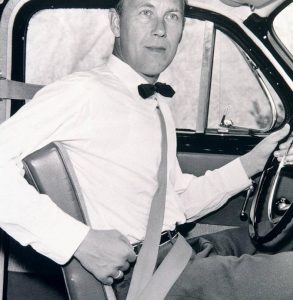Where does Volvo’s reputation for safety come from?
Volvo cars have an enduring reputation for being safe. In fact, it has become a cornerstone of the brand’s identity. However, a great deal of people are unaware of where this reputation comes from. At the Wyant Group, we thought it would be a great idea to shed light on why the brand’s vehicles have acquired such a great reputation for safety.
Over one million lives saved
Volvo began investing in safety early in its history, but the breakthrough that has shaped the brand’s identity is without question the fact they invented the three-point seatbelt. Volvo engineer Nils Bohlin came up with the idea, and it was introduced into the series production PV544 in 1959.

Image: Volvo Cars
Just as impressive as the invention is the fact that Volvo Cars waived its patent rights to the three-point seatbelt so more people could benefit. Since then, it’s estimated that over one million lives have been saved as a result.
Innovation
The invention of the seat belt might be Volvo’s most famous accomplishment, but it is far from their only one in the domain of road safety. The brand has pioneered a myriad of active and passive safety features. In terms of child safety, Volvo came up with the rearward-facing Child Safety Seat in 1972, and further developed this concept with the child booster seat in 1976. All before offering an integrated booster built right into the seat in 1990. Volvo also further developed the integration of airbags as part of a vehicle’s safety features and was the world’s first manufacturer to introduce side-impact airbags.
Volvo’s City Safety system introduced in 2008 was yet another game-changer. Allowing the vehicle to brake or slow down autonomously to prevent or mitigate collisions with other vehicles, the system can now include pedestrian, cyclist and large animal detection. The invention is yet another example of Volvo’s pioneering when it comes to road safety. In fact, consider that a decade later, most automotive companies are implementing similar features on their cars. We could go on and on but quite frankly, we’d like to keep you entertained and tell you about other aspects of Volvo’s pursuit for safety. So instead, we’ll leave this to a telling statistic: since the Volvo XC90 went on sale in the United Kingdom in 2002, over 50,000 have been sold and to this day, not a single occupant has ever been killed in a collision!
State of the art testing facilities

Image: autoevolution
All of Volvo’s innovations in the domain of road safety can in large part be attributed to the company’s state of the art crash testing facilities. Thanks to two test tracks, the brand can simulate collisions in any direction, be it various frontal collisions, side impacts and rear-end collisions, against barriers or other vehicles and at speeds of up to 120 km/h. If that wasn’t enough, the facility also has the capability to conduct roll-over tests and a large outdoor area to simulate different types of full-scale traffic environments. Every year, Volvo crash-tests around 400 vehicles in this facility. Needless to say, Volvo takes the safety of its cars very seriously.
Crash Investigation Team

Image: Volvo Cars
Volvo is unique among manufacturers in that it has a dedicated team that analyses road accidents. The Volvo Cars Traffic Accident Research Team is on standby 24/7, and if a Volvo is involved in an accident in Sweden, they respond to the scene to analyze the circumstances of the accident, collect data and build evidence that will help make future Volvo’s even safer. Since 1970, this team has studied more than 40,000 real-life accidents involving about 72,000 occupants. The knowledge gained from studying real-life accidents is a key factor in developing safer cars.
A driving principle

Image: Volvo Cars Canada
As can be seen, Volvo’s reputation for safety is still very relevant today. And although today’s Volvo cars are extremely safe, the manufacturer continues to set ambitious targets for itself. The initiatives presented above are part of a concerted effort by the Volvo brand that “no one should be killed or seriously injured in a new Volvo car” by 2020. This initiative is a driving principle for Volvo. In fact, not only does the brand work on producing safer cars, it even cooperates with the Swedish Transport Administration to help plan the safe roads and traffic infrastructure.
Vision 2020 is a way of thinking and working. It’s like a religion for the company. – Jan Ivarsson, Deputy Director, Senior Technical Advisor, Safety.
Volvo’s heritage certainly plays a great part in the brand’s reputation for building safe vehicles, but based on the brand’s continued innovation in this field, it’s safe to say that this reputation is well deserved. That the brand continues to set itself ambitious targets is further evidence of how protecting and caring for people is at the heart of Volvo Cars’ philosophy.





